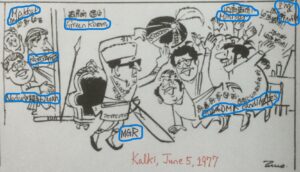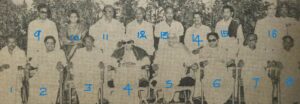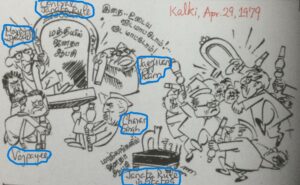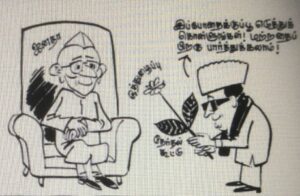Chief Minister – Tangling with the Cerberus dog of the Center
by Sachi Sri Kantha, March 25, 2024
Kannan’s critical comments and my response
I provide MGR scholar and my pal Kannan’s critical comments on the content of Part 74 (received on Jan 20, 2024) below:
“Many thanks indeed for part 74 and the three articles, including the Filmfare article, which I had not seen before.
I want to comment on the five achievements of MGR you listed. Today, thirty-six years after his death, MGR is remembered for the expanded midday meal scheme and the public-private partnership in professional and higher education, turning Tamil Nadu into a state with high human resource capacity. It also boasts some quality professional institutions in the private domain and a slew of hospitals, making Chennai one of the preferred destinations for good medical care. I wonder if MGR could or needed to fend off the RAW machinations. MGR was in the US and was not in a position to assist the LTTE when the IPKF-LTTE hostilities began. This is why Prabhakaran turned to Karunanidhi, who became a fierce champion of the LTTE despite the Tigers having ignored him till then. I would not consider making the Kannadasan poet laureate, the World Tamil Conference, or the Thanjavur Tamil University [as] achievements. Namakkal Ramalingam Pillai was a poet laureate during the Congress administration. Kannadasan, with or without the poet laureate title, was a phenomenon.”

Cartoon 1 – MGR’s predicament in forming a Cabinet, 1977
My response to Kannan’s comments, sent on the same day were as follows:
“I very much appreciate this input from you..Your comments are well taken. My answer: perceptions do differ. But, with your comments, you have given me hints to expand more on MGR’s role in aiding LTTE during the IPKF-LTTE conflict. .
Yes, I’m on your side that Kannadasan was a phenomenon, even without the poet laureate crown. I have listened to poet Muthulingam commenting on this particular issue, in one of his Youtube interviews. The gist of what he said was this. ‘Namakkal Ramalingam Pillai was the 1st Tamilnadu poet laureate. But, Rajaji after he became the CM of Tamilnadu, abolished it for the reason – ‘It was simply a waste of funds’! Maybe, Rajaji might have had some other issues as well. Then, the position was not filled during the terms of Kamarajar, Bhaktavatsalam, Anna and Karunanidhi. When MGR became CM, he re-established the honor and chose Kannadasan for it. Though, Kannadasan had been a severe critic of his politics for long. That showed MGR’s magnanimity for his penchant critic. After Kannadasan’s death, he nominated Pulamaipithan and himself (Muthulingam). Then, the post was left vacant.’
I remember Muthulingam commenting, that Karunanidhi could have appointed another poet laureate – but as he himself was a poet and lyricist, he would have opted not to recognize another guy.
My view (differing from yours) is this – Karunanidhi had shouted from the roof top about protecting mother Tamil and Tamil literature and that MGR was a Malayalee – but why he failed to give due recognition for those who had done service to Tamil? This was the reason, I heard in Madurai from a few commoners, when I attended the 5th International Tamil Conference in 1981. ‘That guy screams about ‘Tamil – Tamil’, and when we are celebrating Mother Tamil’s elegance, he cannot come down from Madras to Madurai, telling a phony reason about invitation. But, many others have come here, from distant countries to experience Tamil culture.’
In my view, even assuming that MGR was a Malayalee by birth only (according to Karunanidhi’s politics since Oct 1972; he wouldn’t say this in public from 1947 to 1972) but he had lived all his life in Kandy, Kumbakonam and Tamil Nadu, he showed respect to Tamil, in his deeds. It was more a humanitarian act by MGR that he assigned the laureate crown to Kannadasan (who had been his critic) and not to Vaali, whom MGR had propped up against Kannadasan since 1960s.”
Events in the Second Half of 1977
Though I had ended Part 74 with an India Today report of May 31, 1978, that indicated that MGR’s popularity was waning in 9 months, it was not to be. As it has been stated, that ‘journalists write the first draft of history, which turns out to be more or less wrong!’ Until his death in December 1987, MGR’s standing in Tamil Nadu politics couldn’t be usurped either by his rivals (Karunanidhi, Indira Gandhi and other lead Congress Party players like Rajiv Gandhi, R. Venkataraman, Karupiah Moopanar) or by those within his own party (like S.D. Somasundaram and Jayalalitha) who made pretense to claim MGR’s aura.
Once the MGR’s party won the State Legislative Assembly elections, there prevailed clamor among the elected MLAs for the Cabinet minister positions. The Kalki weekly’s cartoon of June 5, 1977 (Cartoon 1) depicted MGR’s predicament neatly. In the Green room, where MGR was dressing up for coronation, quite a number of about to be elected MLAs begging for his attention by shouting ‘Minister’ / ‘I’m Minister’. At the same time, three guys from Nedunchezhiyan-led splinter group from DMK, who failed to receive tickets on MGR’s party to contest the election were also ogling the scene, for his attention. Luckily for MGR, among the leading contenders in his party, only one (his namesake, Panruti Ramachandran) had previously held a Cabinet minister position. Among the Navalar Nedunchezhian’s splinter group (Makkal DMK party, formed in April 1977), there were few senior hands like K. Rarajam, S. Madhavan, S.B. Adithan as well as Nedunchezhiyan. from DMK. Tactically, MGR kept them waiting for some time and didn’t offer Cabinet positions. All the MLAs elected under his Anna DMK party symbol were younger to him. Thus, it was not a headache for MGR whom to choose. Whom MGR relied upon to choose his Cabinet team remained a secret. His first Cabinet constituted in July 1977 comprised of 14 ministers, including MGR. A photo published in the Ananda Vikatan magazine is presented nearby, and ministers in the photo are identified as below. Kannan helped me in identifying quite many individuals from this blurry photo. I provide the years of birth and death of listed, what I could find out, with a few notable omissions.

MGR’s first Cabinet members (Ananda Vikatan, July 10 1977)
Seated (from Lt to Rt)
- Aranganayagam (1931-2021) – Education
- Panruti S. Ramachandran (b. 1937) – Public Works
- Narayanasamy Mudaliar – Law
- MGR (1917-1987) – Chief Minister with portfolios Revenue, Industries and Health
- Prabhudas Patwari (1909-1985), Tamil Nadu governor
- Nanjil K. Manoharan (1929-2000) – Finance and Leader of the House
- R. Edmund (1931-2013) – Food and Cooperation
- M. Veerappan (b. 1926) – Information and Publicity
Standing (Lt to Rt)
- Raja Mohammed (?) – Handlooms and Textiles
- T. Saraswathy (1935-2009) – Social Welfare
- Raghavanantham (1917-1999) – Labor
- Soundarapandian (?) – Adi Dravida Welfare
- Kalimuthu (1942-2006) – Local Administration
- Ponnaiyan (b. 1942) – Transport
- Kolandaivelu (?) – Agriculture
- An official, probably the Secretary of the Cabinet (our guess)
The composition of the Cabinet included 8 lawyers, 2 cinema industry personalities (MGR and his long-term assistant cum manager Veerappan), 2 journalists and one engineer (Panruti S. Ramachandran); one woman (P.T. Saraswathy) and one Muslim (Raja Mohammed). Only the then No.2 in the party, Nanjil K. Manoharan had been an elected Lok Sabha MP for DMK for three consecutive terms, from 1962, 1967 and 1971. Panruti Ramachandran had been a minister in the Karunanidhi’s DMK Cabinet. MGR himself had served two terms (1967 and 1971) in the Tamil Nadu Legislative Assembly.
A report by Rangaswamy Parthasarathy that appeared within the first 50 days of MGR’s tenure as the Chief Minister traced the developments MGR had to face immediately.
“When he [MGR] and his team of 14 ministers (including a woman) were sworn in on the last day of the month [June], patches of grease paint were still faintly visible on his face and his tired eyes spoke of the many hours spent facing the camera. Within four days of assuming office, he had the Assembly summoned and within a week, the Governor outlined the new government’s policy, in his inaugural address to the Assembly.
Inside the Assembly, the going was not easy for MGR and his colleagues, most of whom were strangers to parliamentary conventions, rules and procedure. In fact, some of them have not seen the inside of an Assembly before. In contrast, the ranks of the main Opposition led by the DMK leader M. Karunanidhi, had experienced administrators and parliamentarians who had tasted power and ruled the State for nine long years.
The first week of Assembly proceedings, when it discussed the Governor’s address, was a noisy session with the Treasury benches and DMK members at each other’s throats. DMK members delighted in teasing, ridiculing and challenging the AIADMK ministers who did not have many experienced members on their side to pay them back in their own coin….
Parthasarathy also highlighted two issues with which Karunanidhi had needled MGR. The first was the Hindi imposition in Tamil Nadu, against the will of the people. The second was the ‘demand for more powers to the State’ which Karunanidhi promoted assiduously as ‘Maanila Suya Aatchi’’ (Regional Autonomy). According to Parthasarathy,
“MGR was emphatic that his government would not accept the three-language formula [i.e, Hindi, English and the regional language of the State] but would stick to English and Tamil. Amidst cheers from all sides, he declared that where fighting the Centre against imposition of Hindi was concerned, he and Karunanidhi would act as a double=barreled gun [i.e. in Tamil, irattai kuzhal tuppaki] MGR’s strong language prompted a letter from the prime minister [Morarji Desai] advising him not to make pronouncements on such controversial questions without first discussing them with him….
The other controversial issue mentioned in the Governor’s address is the demand for more powers to the State, which the DMK too had demanded under the label of state autonomy. On this point also, Morarji Desai had advised MGR not to make it a public issue.
Morarji Desai’s weak grip of the Prime Minister chair
At the time MGR assumed the Chief Ministership, Morarji Desai who succeeded Indira Gandhi in 1977 was profiled as follows by Raman,
“At 82 [sic, 81], he walks erect, talks firmly and thinks clearly and fearlessly. He is known to be a dry puritan: austere, aloof, arrogant. His 19 months’ detention in Mrs. Gandhi’s prison has, by all accounts, mellowed him. A fiercely uncompromising prohibitionist, vegetarian and champion of time honoured Indian traditions, values and norms of public conduct, he is a convinced follower of Mahatma Gandhi’s directives in letter and spirit; but he has assured the nation that he will not impose his fads and aversions on an unwilling people. He has serious challenged ahead; but with the cooperation of a very able and cohesive team of colleagues, both in the Cabinet and outside, he is confident that he will serve the country with success in a true democratic spirit.”

Cartoon 2 – Janata Party rulers in Centre and States of India, 1979
But this was not to be. After the electoral victory of the Janata Party in March 1977, there were three contestants for the prime minister position. Morarji Desai, Chawdary Charan Singh and Jagjivan Ram – all three were originally in the Congress Party and either deserted it or were expelled. They belonged to three different castes. Morarji was a Brahmin, Charan Singh represented the Jat (farmer) caste and Jagjivan Ram belonged to the lowly untouchable caste. There was infighting. Two years later, a Kalki weekly cartoon of April 29, 1979 (Cartoon 2) caricatured this infighting among these three leaders, in addition to Vajpayee belonging to Jan Sangh party as pulling the ‘throne chair’ of the Central government in different directions. Due to this, much vaunted stability in direction was destroyed.
As journalist Inder Malhotra perspicuously noted in his biography on Indira Gandhi, none of the three claimants for the prime minister chair ‘had a clear majority in the newly formed (Janata) party, but any two could block the third.’ Later events indicated clearly that Indira, with guile, tactically used this imbroglio situation to bring down first Morarji Desai and then Charan Singh!
The Left centered politicians among the Janata group favored the younger (then 68 years) Jagjivan Ram as the prime minister. But he was unacceptable to the 2nd leading contender Charan Singh and many in the Jan Sangh party clique favored Morarji Desai. Eventually ideological contradictions and personality conflicts among the three contestants took their toll within a year and by June 1978, Charan Singh had to resign from the Morarji Desai Cabinet.
Morarji Desai could hold the prime minister position only for 2 years and 126 days, from Mar 24, 1977 to July 28, 1979. Charan Singh’s prime minister tenure was only limited to 170 days, from July 28, 1979 to Jan 14, 1980. Jagjivan Ram never became the prime minister. It was MGR’s bad luck that his first tenure of the Tamil Nadu chief minister had to tangle with the bloated egos of these three ex-Congress Party politicians holding influence in the Central government. Due to this factor, the Janata Party of 1977 was like a Cerberus dog.
For the un-initiated, I provide the following description on Cerberus, from the ‘Encyclopedia of Hell’ (1998) authored by Miriam van Scott.
‘Cerberus is the Greek mythological guardian of the underworld. He is a ferocious three-headed dog with serpent’s tails and a body entwined with vipers. Cerberus sits at the gates of HADES, gnawing on human bones. His duty is to prevent the dead from escaping and the living from invading the underworld. Cerberus’s fierce howling and putrid stench are so frightening that few even dare approach the passageway.’
In fact, there appeared cartoonist depiction of Janata Party as a scary un-named animal with three heads in the Tamil weekly Kalki! Morarji Desai was like a wounded dog. He was passed over for the prime minister positions, not once but twice – in 1964 following Nehru’s death, and in 1966 after Lal Bahadur Shastri’s death. Thus, on seniority basis, he was chosen by the then Janata Party elders Jayaprakash Narayan and J.P. Kripalani. Unfortunately, due to his arrogance, eccentricity and image as the pro-Hindi activist, he couldn’t carry the entire Janata MPs along with him. To block his rivals Charan Singh and Jagjivan Ram gaining, Morarji badly needed numbers, and he badly needed MGR’s 19 MPs for tactical survival. This was the reason, he ditched the alliance with DMK, once the March 1977 elections were over, because Karunanidhi could offer only one MP. For his own future prospects, MGR also opted for cooperation with Morarji Desai’s Cabinet, as depicted in the Kalki cartoon of April 17, 1977. (Cartoon 3) The cartoonist had depicted MGR offering a flower (tagged as cooperation) with two leaves (tagged as electoral alliance). Two leaves were MGR’s party symbol. MGR was pouting ‘For the moment, please accept my cooperation. About electoral alliance, let’s view it later’.

Cartoon 3 -Kalki cartoon (Apr 17, 1977) – MGR offering flowers to Morarji Desai for temporary cooperation
Karunanidhi recorded his annoyance at Morarji Desai for ditching DMK from Janata alliance, as follows:
“[I] met Premier Morarji on April 7th morning at his residence. In between, pal Madhavan who had come directly to Delhi from Chennai also came to premier’s residence. During that meeting, Murasoli Maran was also with us. I handed the letter given by J.P. [Narayan] at Bombay to Morarji. After reading the contents, Morarji Desai was silent for a minute, and looked at us and told, ‘I alone cannot make a decision on [this]. It’s to the Cabinet to make a decision.’ I told him, the contents in J.P.’s letter, I don’t know.
Morarji: ‘J.P. had written ‘We already had told that the cases hoisted on DMK ministers by Indira were politically motivated. Thus, it’s better to take action accordingly.’
I left premier Morarji with the thoughts that while J.P. had wanted to respect his given word sincerely, [this] Morarji is now thinking in a different angle.”
Subsequently, Karunanidhi also had noted the following: ‘Reporters had asked Premier Morarji Desai in Bombay on May 6 [1977], ‘Will there be an alliance with Janata and DMK in Tamil Nadu, for the Legislative Assembly elections?’ Morarji’s response was ‘It’s all over. Now, we don’t have an alliance’.
MGR’s discomfort with Indira’s Congress and contempt for bureaucracy
An unsigned commentary (Anon 1) which appeared before the March 1977 Lok Sabha elections offered a cryptic tidbit on MGR’s agony in facing the bureaucrats.
“Right from the beginning AIADMK has slavishly supported Indira Gandhi’s policies. It welcomed the declaration of Emergency with open arms and demanded the dismissal of the Karunanidhi ministry for not supporting the Emergency wholeheartedly. More loyal than the king, when the DMK ministry was arbitrarily dismissed, the AIADMK recommended the banning of the DMK party as well. Subtle changes, however, started to appear with President’s rule. Heady with their new-found power, some elements in the Congress started to attack AIADMK as being a chip of the same DMK block. MGR counselled patience among his followers, but as Congress bossism became more naked, the rift started to widen. When some of the disgruntled leaders in AIADMK rebelled and left the party, one of them, a Member of Parliament, gave a public statement alleging that MGR had said in private: ‘You people can talk anything, but you do not know the pressures on me. I was interrogated for six hours by IT officials, without even being offered a seat.’ MGR’s problems with the income-tax department are public knowledge and he has often referred to them, but the connection between them and his political stance is anybody’s guess.”
Italics were added by me, for emphasis. This indicates that MGR, one with abundance of pride, was bidding his time patiently to ‘teach’ the Congress Party politicians and bureaucrats a taste of their medicine at a later time.
The dictum of Roman poet Horace (65 BC – 8 BC), ‘Carpe diem, quam minimum credula postero’ [Enjoy today, trusting little in tomorrow], clipped to the first two words Carpe diem [Seize the day] had remained a powerful mantra for politicians of all countries for the last two millennia, and Indians cannot be an exception. What MGR and Morarji Desai did in 1977, was repeated by Indira Gandhi and Karunanidhi in 1979, while MGR was alive. Panneerselvan, a biographer of Karunanidhi, would cynically record MGR ditching Indira in favor of Morarji as follows:
‘It was not easy for the DMK in general and Karunanidhi in particular to deal with a government led by MGR and his ability to constantly shift the goalpost – sometimes in the opposite direction.’
What Panneerselvan had ignored was Karunanidhi’s chauvinism to project himself as an unvarnished, heroic leader of the 20th century Tamils, not only in India, but also in other lands where Tamils are alive. A political correspondent (Anon 2) wrote in a post-election postmortem scene in Tamil Nadu, five days before MGR’s oath-taking function, how Karunanidhi played the ‘Malayalee card’ to capture the Tamil votes.
“The main thrust of the DMK’s campaign against the AIADMK was the spectre of a non-Tamil – MGR is a Malayalee – becoming the chief minister. The first assurance that Karunanidhi gave the people after being elected the opposition leader was that his partymen would not hesitate to lay down their lives should Tamil culture and heritage be endangered. Tamil chauvinism, reminiscent of the anti-Malayalee hysteria whipped up by the DMK, specially to disrupt working class unity, in the past, had a field day. The self-styled national integrationists like C. Subramaniam and his minions joined the chorus, not in the least embarrassed by their past denunciations of DMK’s parochialism, dubbing the Janata as anti-South and loaded only with Northern leaders.
Not daring to reject regional chauvinism boldly, MGR indulged in more of it by engaging in alleged research to establish his own pure Tamil ancestry and the non-Tamil roots of Karunanidhi!”
But the illiterate electorate of Tamil Nadu had voted to elect MGR, in preference to Karunanidhi as well as Tamil Nadu Congress leaders C. Subramaniam and Karupaiah Moopanar. The same correspondent (Anon 2) also inferred, “The fact still remains that it is MGR’s reluctance to share power with the Congress and his anxiety not to cross the new rulers in Delhi that pitted him against the Congress rather than any change of heart on the misdeeds of Congress rule or the horrors of Emergency.”
Even before a month passed since MGR became the Chief Minister of Tamil Nadu, Janata Party’s grip in the Central government was loosening within four months, due to in-fighting between Morarji and Charan Singh. Romesh Tapar noted, “Prime Minister Desai, fully aware of what goes on, is taking a rather benign philosophical view. Nothing panics him these days. It is God’s will, as it were. It’s an attitude that is disconcerting for the manipulators. For example, when on the eve of the Assembly elections, Charan Singh sent in his resignation, the PM’s reaction was to accept it – not in anger, not in sorrow, but in good faith!”
Cited Sources
Anon 1. Election parole. Economic and Political Weekly, Annual number, Feb 1977, pp. 179 – 181.
Anon 2. Glamour politics in command. Economic and Political Weekly, June 25, 1977, pp. 1009 – 1010.
Hardgrave R.L. India: From Crisis to Crisis. Current History, 1979; 76: 159-163 and 180.
Karunanidhi M. Nenjukku Neethi [Justice to the Heart], vol. 3, Thirumagal Nilayam, Chennai, 1997, pp. 93-95, 119-120.
Malhotra I. Indira Gandhi – a Personal and Political Biography, Hodder and Stoughton Ltd., London, 1989.
Miriam van Scott. Encyclopedia of Hell, St. Martin’s Press, New York, 1998, p. 54.
Panneerselvan A.S. Karunanidhi – a Life, Penguin/Random House India, Gurgaon, Haryana, 2021, pp. 250-266.
Parthasarathy R. Janata Party’s sweeping success marred by AIADMK in Tamil Nadu. India Today, Aug 15, 1977.
Raman A.S. Exit Czarina Indira. Contemporary Review, July 1, 1977, pp. 26-28.
Tapar R. Inside the Janata Party. Economic and Political Weekly, July 23, 1977, p. 1165.
I was in high school during the events in this article and even though I was aware of these events, I was not aware of the details in this article explaining the undercurrents behind the scenes. In particular, MGR had to stand for 6 hours during IT raid! This practice is followed by all central governments in India and the current Modi Government has taken this practice of threatening political opponents by IT raids to extreme level! As Dr. Sachi says, till death MGR was the undisputed leader of Tamils.